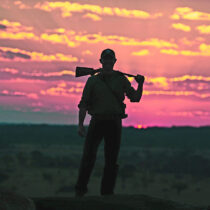
Hippo hunting is an amphibious adventure. You may end up in a dug out canoe paddling towards a group of them, or slipping through the tall grass after a solitary bull. Hunting hippo is a great side adventure to add to you big game safari, or you can book a great hippo and croc combination hunt. When out of the water a body shot can be used with a large caliber and solid bullets. Usually the head shot is preferred and a hunter must be sure that he knows the location of the brain. A hippo shot in the water with a good brain shot will just sink out of sight. A missed brain shot will usually concuss the animal causing him to thrash about. At this time back shots should be administered at a high rate of speed without wounding any other hippo. The dead animal will float after a few hours due to the vegetation in its stomach producing enough gas to float the carcass. I will provide you with diagrams and advise on shot placement.
The trophy of a hippo is associated with the animal’s 12 tusks. The longest canine tusk length is the measurement recorded by the record books. As far as trophy assessment goes we are looking for a mature bull and hope for the best on its tusks. You can make an educated guess on the teeth size by evaluating the ‘pockets’ on the top of the hippos jaw. These can indicate tusks size. If time is available you can wait for it to open his mouth for a visual confirmation.
The fun is in the hunt, it can be equated to pig hunting in that the size of the trophy is not considered to be of the utmost importance. Any mature hippo is going to be a huge animal and a pleasure to hunt on a safari. Hippo are CITIES II animals and are allowed to be imported into the USA.
General Hippo Information
- Average lifespan in the wild: Up to 40 years
Size: Head and body, 9.5 to 14 ft. (2.8 to 4.2 m); Tail, 13.75 to 19.75 inches (35 to 50 cm)
Weight: 5,000 to 8,000 lbs. (2,268 to 3,629 kg)- Group name: Pod
- Hippopotamuses love water, which is why the Greeks named them the “river horse.” Hippos spend up to 16 hours a day submerged in rivers and lakes to keep their massive bodies cool under the hot African sun. Hippos are graceful in water, good swimmers, and can hold their breath underwater for up to five minutes. However, they are often large enough to simply walk or stand on the lake floor, or lie in the shallows. Their eyes and nostrils are located high on their heads, which allows them to see and breathe while mostly submerged.
Hippos also bask on the shoreline and secrete an oily red substance, which gave rise to the myth that they sweat blood. The liquid is actually a skin moistener and sunblock that may also provide protection against germs.- At sunset, hippopotamuses leave the water and travel overland to graze. They may travel 6 miles (10 kilometers) in a night, along single-file pathways, to consume some 80 pounds (35 kilograms) of grass. Considering their enormous size, a hippo’s food intake is relatively low. If threatened on land hippos may run for the water—they can match a human’s speed for short distances. They are insecure out of the water and will flee to water when threatened. Many human deaths can be attributed to a person unwittingly placing himself between this animal and the water’s edge. They will attack under some circumstances and have been known to regularly charge humans and flip over small boats.
- Hippo calves weigh nearly 100 pounds (45 kilograms) at birth and can suckle on land or underwater by closing their ears and nostrils. Each female has only one calf every two years. Soon after birth, mother and young join schools that provide some protection against crocodiles, lions, and hyenas.















